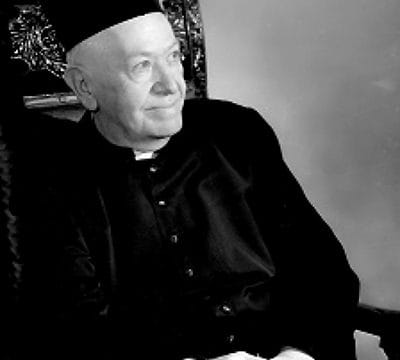Poverty in Alabama
Since the Civil War, Alabama has been one of the nation’s poorest states. According to 2019 estimates by the U.S. Census, Alabama was the seventh poorest state, with 15.5 percent of its residents living in poverty, as compared with a U.S. average of 11.1 percent. The state also contained five of the nation’s 100 poorest counties, ranked by median household income. The origins of this poverty are complex. Some states are poor because they lack natural resources. That is not the case in Alabama, which contains abundant water, timber, and mineral wealth. The roots of its poverty lie in its social, political, and economic policies.
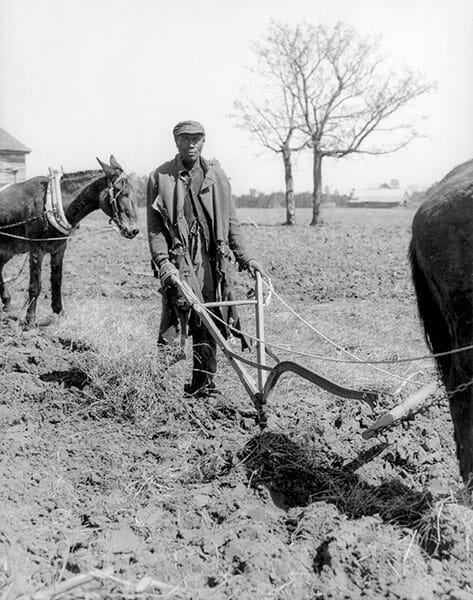 Montgomery County Sharecropper
The state’s long history of slavery, segregation, and racial discrimination helps explain the extremely high rate of poverty among African Americans. The state’s economic development strategy throughout the nineteenth and most of the twentieth centuries is another source. It was rooted in desperate attempts to attract low-skill, low-wage industries, such as textiles, with tax exemptions coupled with government repression of unions that could have pushed for higher wages. The 1901 Constitution, largely written in reaction to the class-based Populist revolt that nearly destroyed the control over the state’s wealth that the upper classes enjoyed in the 1890s, disfranchised nearly all African American males and a significant number of poor and working-class whites. It also enacted property-tax limitations that made it difficult—if not impossible—to raise property taxes, thus placing much of the tax burden on state sales taxes and other regressive levies that fell and continue to fall disproportionately on the poor. Insufficient tax revenues starved the state’s education and public health programs, which otherwise might have helped poor people rise out of poverty. Drug and alcohol abuse, teenage pregnancy, and low emphasis on education among the chronically poor, resulting from their often hopeless situations, accounted for a small portion of their condition.
Montgomery County Sharecropper
The state’s long history of slavery, segregation, and racial discrimination helps explain the extremely high rate of poverty among African Americans. The state’s economic development strategy throughout the nineteenth and most of the twentieth centuries is another source. It was rooted in desperate attempts to attract low-skill, low-wage industries, such as textiles, with tax exemptions coupled with government repression of unions that could have pushed for higher wages. The 1901 Constitution, largely written in reaction to the class-based Populist revolt that nearly destroyed the control over the state’s wealth that the upper classes enjoyed in the 1890s, disfranchised nearly all African American males and a significant number of poor and working-class whites. It also enacted property-tax limitations that made it difficult—if not impossible—to raise property taxes, thus placing much of the tax burden on state sales taxes and other regressive levies that fell and continue to fall disproportionately on the poor. Insufficient tax revenues starved the state’s education and public health programs, which otherwise might have helped poor people rise out of poverty. Drug and alcohol abuse, teenage pregnancy, and low emphasis on education among the chronically poor, resulting from their often hopeless situations, accounted for a small portion of their condition.
Prior to the Civil War, nearly all blacks were poor, and approximately 10 percent of whites owned neither land nor personal property, such as horses, mules, or farm implements. One Montgomery paper estimated in 1848 that 50,000 poor and unemployed whites were available for work if only there were jobs for them. Industrialist Daniel Pratt emphasized that his textile and manufacturing businesses were an outgrowth of his religious philanthropy, particularly his eagerness to provide work for poor white families. In 1851, 42 percent of Mobile‘s white school-age children did not attend school, and nine years later 353 white children between the ages of 12 and 17 were working as bricklayers, clerks, painters, dressmakers, or other low-paying jobs. The 1860 census listed thousands of whites as day laborers, farm laborers, “hirelings,” “farm hands,” and “ditchers,” or as indigent and propertyless.
 Hale County Sharecroppers
The economic upheaval of the Civil War and Reconstruction made matters worse for many whites and helped blacks only marginally. Declining land values and cotton prices, globalization of the cotton economy, endemic diseases that sapped the health of rural people, and population growth, which divided farms into smaller and smaller parcels among heirs, all contributed to a decline of small white farmers into tenancy and poverty. Initially, blacks profited from Reconstruction, gaining some control over their own mobility and earning the right to negotiate their labor and residency through labor and tenancy contracts. Though better than slavery, such arrangements still locked them into a system of rural poverty not much better than their former arrangements. By the 1880 Census, only 53 percent of Alabama farmers owned their land. The rest had descended into some form of farm tenancy. Over the next 50 years, many of these tenants deserted the land for other states or for low-wage jobs in coal mines, iron and steel mills, textile factories, and the timber, turpentine, and pulpwood business. Although farm prices improved enough to sharply reduce rural poverty during World War I, the post-war collapse of cotton prices sent them plunging downward again. In 1910, 43 percent of white farmers were tenants; by 1930, the figure had risen to 47 percent; in 1930 Alabama’s total tenancy rate for both races of 65 percent was the nation’s fifth highest. A combination of the unintended effects of the New Deal, whose agricultural policies forced millions of tenants off the land, and the attraction of urban jobs in defense industries, absorbed millions of displaced poor whites and blacks into blue-collar jobs in the lower middle class during World War II.
Hale County Sharecroppers
The economic upheaval of the Civil War and Reconstruction made matters worse for many whites and helped blacks only marginally. Declining land values and cotton prices, globalization of the cotton economy, endemic diseases that sapped the health of rural people, and population growth, which divided farms into smaller and smaller parcels among heirs, all contributed to a decline of small white farmers into tenancy and poverty. Initially, blacks profited from Reconstruction, gaining some control over their own mobility and earning the right to negotiate their labor and residency through labor and tenancy contracts. Though better than slavery, such arrangements still locked them into a system of rural poverty not much better than their former arrangements. By the 1880 Census, only 53 percent of Alabama farmers owned their land. The rest had descended into some form of farm tenancy. Over the next 50 years, many of these tenants deserted the land for other states or for low-wage jobs in coal mines, iron and steel mills, textile factories, and the timber, turpentine, and pulpwood business. Although farm prices improved enough to sharply reduce rural poverty during World War I, the post-war collapse of cotton prices sent them plunging downward again. In 1910, 43 percent of white farmers were tenants; by 1930, the figure had risen to 47 percent; in 1930 Alabama’s total tenancy rate for both races of 65 percent was the nation’s fifth highest. A combination of the unintended effects of the New Deal, whose agricultural policies forced millions of tenants off the land, and the attraction of urban jobs in defense industries, absorbed millions of displaced poor whites and blacks into blue-collar jobs in the lower middle class during World War II.
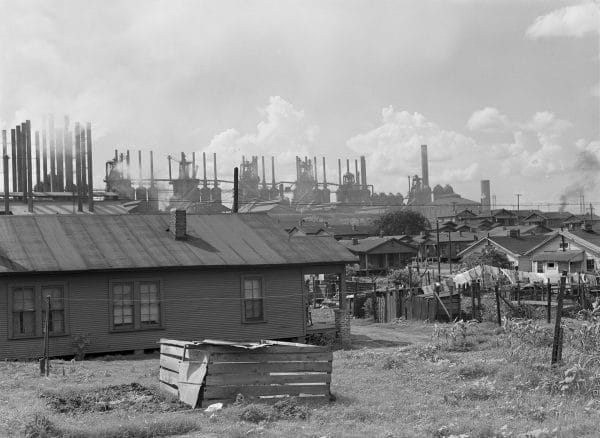 Birmingham Steel Worker Housing
Alabama’s rural landscape was an economic and social tragedy. A 1940 statewide survey valued the dwellings of white rural landowners at only $681 and those of black and white tenants at barely half that amount. Only 1.4 percent of these rural houses contained running water, 0.7 percent a flush toilet, 11.6 percent a refrigerator, and 19.9 percent a radio. Rural houses by and large were dilapidated, unsightly, unpainted, and unscreened, with leaky roofs and outdoor toilets—if they had any toilets at all. Electricity was just beginning to appear in rural communities. As late as the 1960 Census, 28 of Alabama’s 67 counties had poverty rates of 20 percent or more, with children under age 18 most likely to be poor.
Birmingham Steel Worker Housing
Alabama’s rural landscape was an economic and social tragedy. A 1940 statewide survey valued the dwellings of white rural landowners at only $681 and those of black and white tenants at barely half that amount. Only 1.4 percent of these rural houses contained running water, 0.7 percent a flush toilet, 11.6 percent a refrigerator, and 19.9 percent a radio. Rural houses by and large were dilapidated, unsightly, unpainted, and unscreened, with leaky roofs and outdoor toilets—if they had any toilets at all. Electricity was just beginning to appear in rural communities. As late as the 1960 Census, 28 of Alabama’s 67 counties had poverty rates of 20 percent or more, with children under age 18 most likely to be poor.
During the twentieth century, low taxes and the widespread middle-class mythology about the nature of poverty—that most poor people were African Americans, or lazy, shiftless “poor white trash” who refused to work—produced numerous negative consequences. The state’s educational system remained in shambles, especially for blacks and rural whites, family welfare payments were the nation’s second lowest, and the state income tax by the end of the twentieth century was the nation’s most regressive, taking affect when a poor person earned only $4,600 a year.
According to 2019 Census estimates, urban and rural poverty rates were close, 14.8 percent and 18.5 percent, respectively. Children under age 18 experienced a poverty rate of 25.1 percent, and nearly one in three of all children lived in a single-parent family. Black single mothers had a nearly 50-50 chance of being poor, white single mothers a 1 in 6 chance, and black couples, a 1 in 10 chance. In 2019, 13.7 percent of Alabama’s white residents were poor, 31.2 percent of its African American residents were poor, and 33.6 percent of its Hispanic residents were poor.
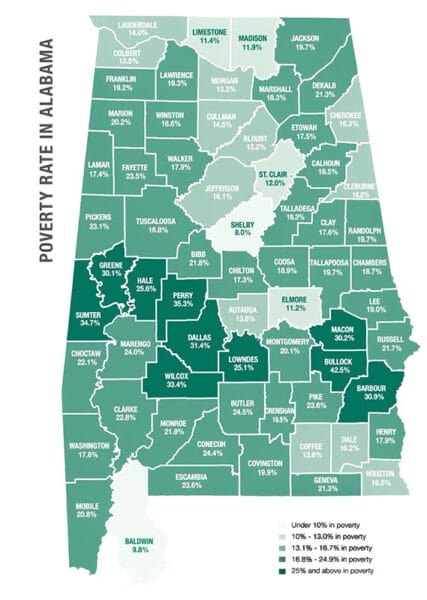 Alabama Poverty Rates by County
In the late twentieth century, economic development leaders in the state stepped up efforts to diversify Alabama’s economy and brought new economic opportunities to the state’s population. Well-paying jobs lifted the state’s per capita income from half the national average at the beginning of the 1930s to more than 83 percent by the end of the century. But by 2019, Alabama’s per capita income had fallen to less than half that of the United States as a whole. Per capita income in 2019 was approximately $28,650, and median household income more than $51,734. Federal programs, such as the Lyndon Johnson administration’s War on Poverty—with its job training, job corps, Medicaid, and Medicare programs—lifted many out of poverty and reduced the national poverty rate from nearly one in four in 1960 to only 11 percent by the mid-1970s. These improvements stagnated during the next three decades, and Alabama’s poverty rate was typically above 16 percent, with highs of more than 20 percent during recessions, such as occurred in the early 1980s. In the twenty-first century, the rate is more than 15.0 percent. The rate of poverty among elderly Alabamians has gone down, but the rate among children has gone up. And for all the efforts to bring jobs to Alabama in the era of open markets and free trade, there were clear winners and losers. In Alabama, low-wage timber and pulpwood workers, textile operatives, and other low-skill employees lost jobs as well-educated skilled workers found enhanced economic opportunities.
Alabama Poverty Rates by County
In the late twentieth century, economic development leaders in the state stepped up efforts to diversify Alabama’s economy and brought new economic opportunities to the state’s population. Well-paying jobs lifted the state’s per capita income from half the national average at the beginning of the 1930s to more than 83 percent by the end of the century. But by 2019, Alabama’s per capita income had fallen to less than half that of the United States as a whole. Per capita income in 2019 was approximately $28,650, and median household income more than $51,734. Federal programs, such as the Lyndon Johnson administration’s War on Poverty—with its job training, job corps, Medicaid, and Medicare programs—lifted many out of poverty and reduced the national poverty rate from nearly one in four in 1960 to only 11 percent by the mid-1970s. These improvements stagnated during the next three decades, and Alabama’s poverty rate was typically above 16 percent, with highs of more than 20 percent during recessions, such as occurred in the early 1980s. In the twenty-first century, the rate is more than 15.0 percent. The rate of poverty among elderly Alabamians has gone down, but the rate among children has gone up. And for all the efforts to bring jobs to Alabama in the era of open markets and free trade, there were clear winners and losers. In Alabama, low-wage timber and pulpwood workers, textile operatives, and other low-skill employees lost jobs as well-educated skilled workers found enhanced economic opportunities.
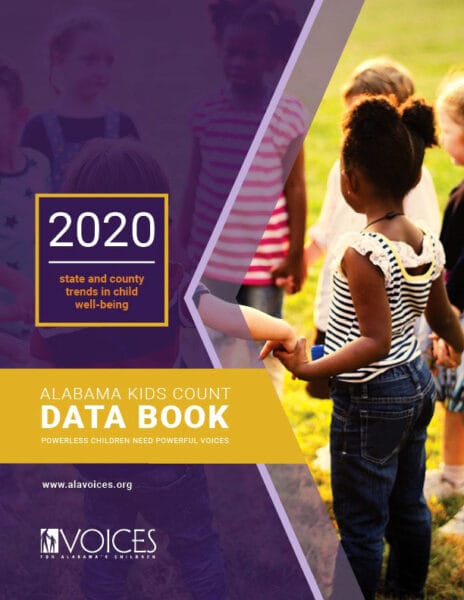 Voices for Alabama’s Children Report
This persistence of poverty has inspired a number of reform efforts, ranging from private charity (food pantries, thrift stores, clothing closets) on one hand to systemic attempts to change Alabama’s 1901 Constitution and the regressive tax system established by it on the other. Groups such as Alabama Arise, Voices for Alabama’s Children, Greater Birmingham Ministries, Alabama Citizens for Constitutional Reform, A+ for Education, the Alabama Poverty Project, and many others mobilized to address poverty by changing the economic systems put in place early in the twentieth century by Alabama’s Big Mules, planters and industrialists who viewed low-skill, low-wage, non-union labor as exactly what the state needed to bring prosperity. The failure of their century-long dominance of Alabama politics and economy to bring wider prosperity or to reduce poverty was the very force that created the new reform efforts at century’s end.
Voices for Alabama’s Children Report
This persistence of poverty has inspired a number of reform efforts, ranging from private charity (food pantries, thrift stores, clothing closets) on one hand to systemic attempts to change Alabama’s 1901 Constitution and the regressive tax system established by it on the other. Groups such as Alabama Arise, Voices for Alabama’s Children, Greater Birmingham Ministries, Alabama Citizens for Constitutional Reform, A+ for Education, the Alabama Poverty Project, and many others mobilized to address poverty by changing the economic systems put in place early in the twentieth century by Alabama’s Big Mules, planters and industrialists who viewed low-skill, low-wage, non-union labor as exactly what the state needed to bring prosperity. The failure of their century-long dominance of Alabama politics and economy to bring wider prosperity or to reduce poverty was the very force that created the new reform efforts at century’s end.
Additional Resources
Flynt, Wayne. Poor But Proud: Alabama’s Poor Whites. Tuscaloosa: University of Alabama Press, 1989.
Jones, Jacqueline. The Dispossessed: America’s Underclass from the Civil War to the Present. New York: Basic Books, 1992.
LaMonte, Edward S. Politics and Welfare in Birmingham, 1900-1975. Tuscaloosa: University of Alabama Press, 1995.


